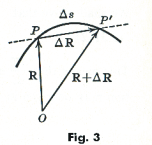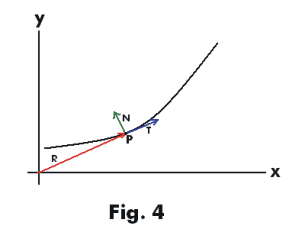
Website owner: James Miller
POSITION VECTOR, VECTOR REPRESENTATION OF PLANE CURVES, UNIT TANGENT, PRINCIPAL NORMAL, CURVATURE, CURVILINEAR MOTION, VELOCITY, ACCELERATION, TANGENTIAL AND NORMAL COMPONENTS OF ACCELERATION

Def. Position vector (or radius vector). The vector
![]()
running from the origin to a point P(x, y) in the plane is
called the position vector or radius vector of P. The
vectors
![]() and
and
![]() are unit vectors along the positive the x
and y axes respectively.
are unit vectors along the positive the x
and y axes respectively.
Plane curves. We can think of a curve in the plane as a path of a moving point. The definition of a plane curve is essentially an analytical implementation of this view. A plane curve is defined parametrically as the graph of parametric equations
1) x = x(t)
y = y(t)
where the functions x(t) and y(t) are continuous and the range of the parameter t is some interval (finite or infinite) of the real axis. In vector language a plane curve is defined as the graph of points traced out by a position vector
![]()
where the functions f and g are continuous and the range of the parameter t is some interval (finite or infinite) of the real axis. The positive direction of a space curve is the direction of increasing t. i.e Δs/Δt > 0.
If we interpret t as time, 1) can be regarded as defining the path of a moving point. The point may pass through the same point in the plane several times which means that the curve may intersect itself. This definition that we have given gives a curve that is very general and one that may not be very smooth. For example, it could include things like the track of a tiny particle in Brownian movement over a long period of time (a very random path going first in one direction and then abruptly changing to another direction — randomly and suddenly changing from one direction to another).
Derivative of a vector. The derivative of a vector

![]()
with respect to t is given by
![]()
The derivative
![]() is a vector
tangent to the curve at the point in
question. See Fig. 2. If the variable t
represents time, then
is a vector
tangent to the curve at the point in
question. See Fig. 2. If the variable t
represents time, then
![]() represents
the velocity with which the terminal point
of the radius vector describes the curve.
Similarly, dv/dt represents its acceleration a along the curve.
represents
the velocity with which the terminal point
of the radius vector describes the curve.
Similarly, dv/dt represents its acceleration a along the curve.
Unit tangent vector. Let a curve C be given by
R(s) = x(s) i + y(s) j
where the parameter s represents the arc length measured from some fixed point on the curve. Then the unit tangent vector to the curve at a particular point P is given by

T = dR/ds
That this is so can be seen from Fig. 3 which shows R and R + ΔR at points P and P'. The quotient ΔR/Δs is a vector along the line of the chord PP'. Since the length of ΔR is the length of the chord PP', we see that when P' approaches P the limit of the length of ΔR/Δs is unity. Furthermore, the limiting direction of PP' is that of the tangent at P. Therefore
![]()
Differentiation of R with respect to t gives
![]()
Note that if t represents time then ds/dt is speed and dR/dt is velocity. From 2) we get

From T = dR/ds we obtain
![]()

Principal normal. The principal normal, denoted by N , at a point P on a curve C, is a unit vector in the direction of dT/ds (providing dT/ds is not zero, in which case the principal normal is not defined). The principal normal is necessarily perpendicular to the unit tangent vector T. It points toward the concave side of the curve. See Fig. 4. From 4) above we obtain
![]()
Curvature of a curve at point P. The curvature κ of a curve at a point P is given by the magnitude of dT/ds:

Thus
7) dT/ds = κN
Radius of curvature. The radius of curvature ρ is the reciprocal of the curvature:
8) ρ = 1/κ
Center of curvature. The tip of the vector ρN, drawn from point P as initial point, is called the center of curvature of the curve at point P.
Velocity and acceleration in curvilinear motion. Consider a point P(x, y) moving along a curve defined by the parametric equations
x = x(t)
y = y(t)
where t is time. The position vector of the moving point is given by
![]()
The velocity is given by
![]()
The magnitude of
![]() is given by
is given by
![]()
where vx and vy are the x and y components of the velocity i.e.
vx = dx/dt
vy = dy/dt .
The direction of
![]() at P is along the tangent to the curve at P.
at P is along the tangent to the curve at P.
The acceleration is given by

The magnitude of
![]() is given by
is given by
![]()
where ax and ay are the x and y components of the acceleration i.e.
ax = d2x/dt2
ay = d2y/dt2 .
Tangential and normal components of acceleration. First note that
![]()
Thus


which gives the resolution of the acceleration vector at P in the directions of the unit tangent T
and principal normal N. Denoting these components in the directions of T and N by
![]() and
and
![]() we have
we have


where
![]() is the radius of curvature of the curve at P.
is the radius of curvature of the curve at P.
Since
![]()
we have
![]()
as a second way of determining
![]() .
.
Jesus Christ and His Teachings
Way of enlightenment, wisdom, and understanding
America, a corrupt, depraved, shameless country
On integrity and the lack of it
The test of a person's Christianity is what he is
Ninety five percent of the problems that most people have come from personal foolishness
Liberalism, socialism and the modern welfare state
The desire to harm, a motivation for conduct
On Self-sufficient Country Living, Homesteading
Topically Arranged Proverbs, Precepts, Quotations. Common Sayings. Poor Richard's Almanac.
Theory on the Formation of Character
People are like radio tuners --- they pick out and listen to one wavelength and ignore the rest
Cause of Character Traits --- According to Aristotle
We are what we eat --- living under the discipline of a diet
Avoiding problems and trouble in life
Role of habit in formation of character
Personal attributes of the true Christian
What determines a person's character?
Love of God and love of virtue are closely united
Intellectual disparities among people and the power in good habits
Tools of Satan. Tactics and Tricks used by the Devil.
The Natural Way -- The Unnatural Way
Wisdom, Reason and Virtue are closely related
Knowledge is one thing, wisdom is another
My views on Christianity in America
The most important thing in life is understanding
We are all examples --- for good or for bad
Television --- spiritual poison
The Prime Mover that decides "What We Are"
Where do our outlooks, attitudes and values come from?
Sin is serious business. The punishment for it is real. Hell is real.
Self-imposed discipline and regimentation
Achieving happiness in life --- a matter of the right strategies
Self-control, self-restraint, self-discipline basic to so much in life